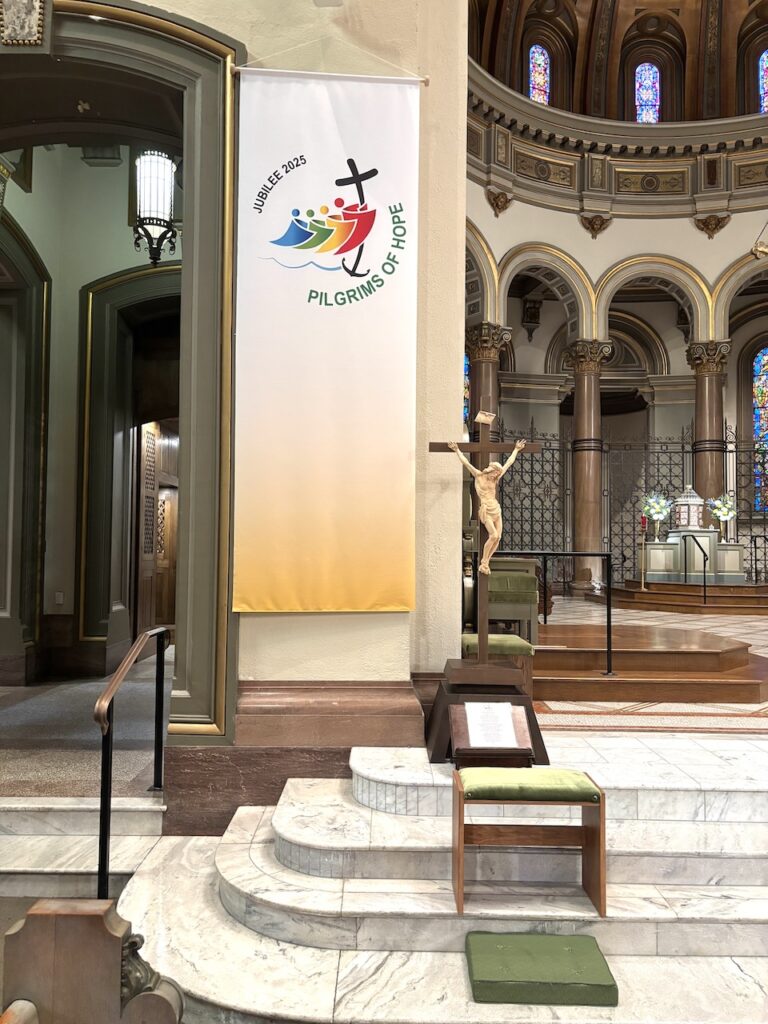Bishop Barry C. Knestout has named four churches in the diocese as pilgrimage sites for the Jubilee Holy Year 2025: the Cathedral of the Sacred Heart, Richmond; the Basilica of St. Andrew, Roanoke; the Basilica of St. Mary of the Immaculate Conception, Norfolk; and the National Shrine of Our Lady of Walsingham, Williamsburg.
Pope Francis released a Bull of Indiction, “Spes non confundit” (“Hope does not disappoint”), last May to announce the Ordinary Jubilee Year, marking 2,025 years since the Incarnation. Jubilee years have typically been celebrated every 25 years in the Church since the 13th century; celebrations include pilgrimages, processions, Masses, opportunities to go to confession, as well as opportunities to obtain indulgences.
Pope Francis declared the theme of this Jubilee Year “Pilgrims of Hope,” writing in his papal bull: “For all of us, may the Jubilee be an opportunity to be renewed in hope.”
The pope officially launched the jubilee in Rome on Dec. 24, 2024. The jubilee then opened in dioceses worldwide five days later; Bishop Knestout celebrated the opening Mass for our diocese at the Cathedral of the Sacred Heart, Richmond, on Dec. 28, during the vigil Mass of the Feast of the Holy Family.
Jubilee indulgences
According to the “Decree on the Granting of the Indulgence during the Ordinary Jubilee Year 2025”: “the faithful, pilgrims of hope, will be able to obtain the Jubilee Indulgence granted by the Holy Father if they undertake a pious pilgrimage” to any designated jubilee site.
Individuals or groups of pilgrims receive the jubilee indulgence if they participate in certain celebrations and/or devotions at the jubilee site, including Holy Mass, Eucharistic adoration, a penitential celebration, Liturgy of the Hours, or other pious exercises, such as praying the Stations of the Cross or the rosary.
An indulgence is a remission before God of the temporal punishment due to sins whose guilt has already been forgiven (CCC No. 1471). After confession, a soul is washed clean, but even so, there remains a punishment for committing the sin, which is served in purgatory. A plenary indulgence removes all of the temporal punishment, while a partial indulgence removes part of it.
“The sacrament of Penance assures us that God wipes away our sins. … Still, as we know from personal experience, every sin “leaves its mark”. … In our humanity, weak and attracted by evil, certain residual effects of sin remain. These are removed by the indulgence” (“Spes non confundit,” No. 23).
The decree states that to receive a jubilee indulgence, the usual conditions for a plenary indulgence remain (including that one must intend to obtain the indulgence):
- True repentance and freedom from any affection for sin (Enchiridion Indulgentiarum, IV ed., norm. 20, § 1)
- Confession
- Holy Communion [“fitting that Communion be received and the prayer for the intention of the Holy Father be said on the same day as the work is performed” (Manual of Indulgences, 20.3.)]
- Pray for the intentions of the Supreme Pontiff

‘Pious pilgrimages’
In addition to designated jubilee pilgrimage sites in Rome and the Holy Land, Pope Francis announced that cathedrals in ecclesiastical areas would serve as local pilgrimage sites, along with any other sacred places chosen by the local ordinary.
At the cathedral in Richmond, pilgrims can venerate a special Jubilee Year cross near the altar in the sanctuary. Father Anthony Marques, rector of the cathedral, explained that according to the norms for the Jubilee Year, the cross used to inaugurate the Jubilee Year during the opening Mass in December will remain in the sanctuary all year for veneration.
A jubilee banner is hanging near the cross, which Pope Francis calls “a sign of hope that does not disappoint.” The Jubilee Prayer is also displayed for pilgrims to pray during veneration of the cross.
Father Marques encourages parishes, schools, or other groups who would like to make a jubilee pilgrimage to the cathedral to contact the parish office to arrange a tour, including the crypt, and a demonstration of the cathedral’s colossal new pipe organ.
He added that it would be especially meaningful in the Jubilee Year for pilgrims to attend the Chrism Mass (April 14) and the priesthood ordination (June 7), both at the cathedral.
Father Kevin Segerblom, rector of the Basilica of St. Andrew, said they are excited about being named a jubilee pilgrimage site. The parish is already beginning to schedule some pilgrimage groups, and Father Segerblom said they are looking forward to hearing from more groups in the coming weeks and months.
The Jubilee Year will conclude in local dioceses on the Feast of the Holy Family Dec. 28, and in Rome on Jan. 6, 2026.

